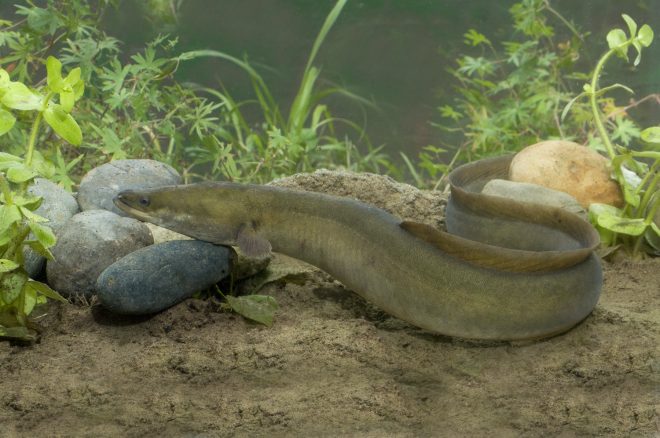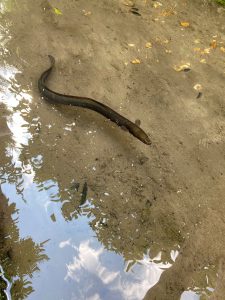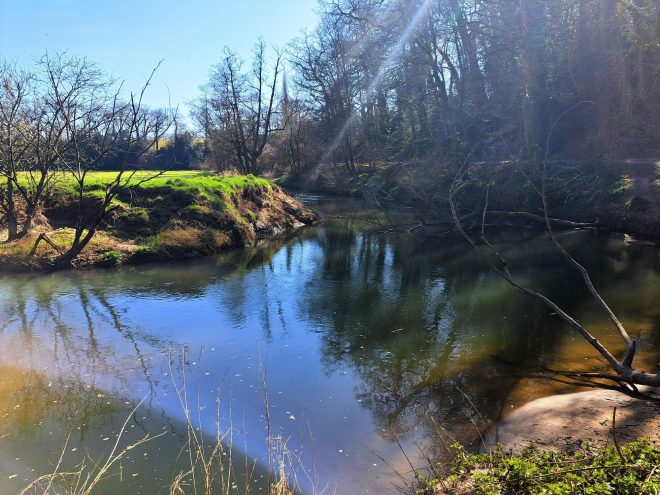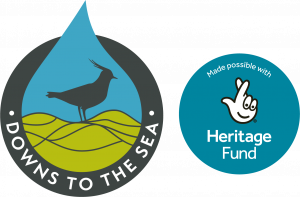South Downs National Park gives helping hand to one of UK’s most mysterious creatures
July 24, 2025

Efforts are under way to help protect the elusive European eel that makes an incredible 4,000-mile transatlantic journey to the rivers of the South Downs National Park.
As National Marine Week begins on 26 July, the National Park and its partners are raising awareness of the strong link between the health of rivers and seas – with eels as a prime example of how nature relies on both.
The European eel, once common but now one of the most endangered animals in the UK, is being given a helping hand in the South Downs as their habitat is being improved along the River Rother and River Ems.
The Western Sussex Rivers Trust is working to remove barriers along the watercourses, as well as install fish passes to help the eels move upstream.
The migration of these eels is quite extraordinary as they undergo several metamorphoses during their lives.
 Spawning in the Sargasso Sea, off the coast of Bermuda, the eel eggs hatch into wriggling pea-sized larvae that have the appearance of a see-through leaf. Over the next couple of years these opaque creatures drift along with the Gulf Stream, their bodies elongating as they enter the next life stage as a “glass eel”. Upon reaching the English coastline they use the force of the tides – and their new-found body shape at around 8cm in length – to push themselves upstream to make a home in rivers, including the Rother and Ems.
Spawning in the Sargasso Sea, off the coast of Bermuda, the eel eggs hatch into wriggling pea-sized larvae that have the appearance of a see-through leaf. Over the next couple of years these opaque creatures drift along with the Gulf Stream, their bodies elongating as they enter the next life stage as a “glass eel”. Upon reaching the English coastline they use the force of the tides – and their new-found body shape at around 8cm in length – to push themselves upstream to make a home in rivers, including the Rother and Ems.
Once in rivers, they go through more life cycles, growing up to 1m in length and living for up to 20 years, gorging on fish, molluscs and crustaceans. The end of their lives sees a fantastic finale. Entering the “silver eel” stage, their pectoral fins widen, muscle mass increases, their digestive tracts shut down and their eyes grow up to ten times their original size, all to help see them through one final swim. Fighting their way back against strong currents, silver eels head 4,000 miles back across the Atlantic to the Sargasso Sea to spawn.

Efforts to help eels on the Rother and Ems is just one of several water-based nature recovery projects in the National Park and part of a broader strategy to improve river, stream, pond and marine habitats. As part of the Downs to the Sea scheme (details below), eel brushes are being included on all the new water control structures installed at RSPB Pulborough Brooks and Pagham Harbour to help migration and encourage eel repopulation.
Aimee Felus, Chief Executive of the Western Sussex Rivers Trust, said: “The health of our rivers here in the South East is crucial to the quality of our coastal waters, and vital to the health of the many creatures who call these fresh and salt waters home.
“Through our River Guardian monitoring project we are pushing for higher water quality improvements, quicker identification of pollution incidents and raising awareness of how all communities can get involved to help protect their local rivers.
“By removing manmade structures which limit how easily fish species, including the extraordinary eel, can move around we are helping improve migration routes and their ability to reach better feeding spots.
“With pollution, sewage and drought all playing a part in the diminishing water quality of our rivers and streams, it’s more important than ever that we work together to help protect and enhance these precious habitats for wildlife and humans alike.”
Jan Knowlson, Biodiversity Officer for the South Downs National Park, said: “The eels we have in the National Park are truly remarkable and their incredible migration underlines the important connection between our rivers and seas. There’s a continuum and all these watercourses are joined up. So healthier rivers ultimately mean healthier seas and vice versa.
“Here at the South Downs National Park, we have eight large river systems, dozens of chalk streams and a sizeable coastline and know that having well-managed, cleaner waterways are absolutely paramount to nature bouncing back across this vast region.”
A number of exciting initiatives in and around the South Downs are currently taking place to help river and marine habitats:

- Earlier this year the “Downs to the Sea” project launched following a grant of £1.7m from the National Lottery Heritage Fund. Thanks to National Lottery players, Downs to the Sea is carrying out much-needed restoration work to a number of internationally-designated wildlife sites, including RSPB Pulborough Brooks and RSPB Pagham Harbour in West Sussex. The initiative will restore 15 ponds in the National Park to create biodiversity hotspots and support the movement of wildlife between sites, increasing resilience to a warmer climate.
- As part as Downs to the Sea, two Water Champions, have joined the team at the Western Sussex Rivers Trust. They will be working with parish councils, communities and young people to help raise awareness of the importance of our riverscapes and how people can take action for their local water environment.
- Efforts are under way to improve the underwater kelp forest that stretches along the coast of Sussex and is home to both the long and short-snouted seahorse. Partners are working together as part of the Sussex Kelp Restoration Project to reduce sediments that flow into the seas from rivers. Sediment in the seawater reduces the amount of light reaching the kelp, hindering its growth and then reducing the amount of habitat for species such as the seahorse and cuttlefish. By improving riverbank management and incorporating more nature-friendly farming, sediment leakage from rivers can be significantly reduced.
For more information visit https://wsrt.org.uk/ and www.southdowns.gov.uk/downs-to-the-sea/ and Rewilding the Sussex seabed | Sussex Kelp Recovery Project
For National Marine Week and as part of Downs to the Sea, a poetic nature walk, led by poet Pauline Rutter and organised by Writing Our Legacy, will take place on 27 July from the Adur River to the Sussex coast. Book a spot here.
- The number of European eels arriving in Britain has fallen by around 95 per cent in the last 40 years. Reasons for the decline include habitat loss, damming, pollution and overfishing.
- They are regarded as critically endangered on the IUCN Red List of Threatened Species.
- The average lifespan is 20 years, but some can live up to 50 years.
- The South Downs National Park’s coastline includes parts of eastern Brighton and the Sussex Heritage Coast, which stretches from Seaford to Eastbourne. This was the first Heritage Coast established as part of a plan to protect and conserve the best stretches of undeveloped coast in England. More than a million people visit the Sussex Heritage Coast each year. The Sussex Heritage Coast group includes Eastbourne Borough Council and the National Trust, who own much of the area, the South Downs National Park Authority, East Sussex County Council, the Environment Agency, Sussex IFCA, Lewes District Council, Natural England, Sussex Wildlife Trust, Wealden District Council and other partners with an interest in coastal matters. Learn more here.
